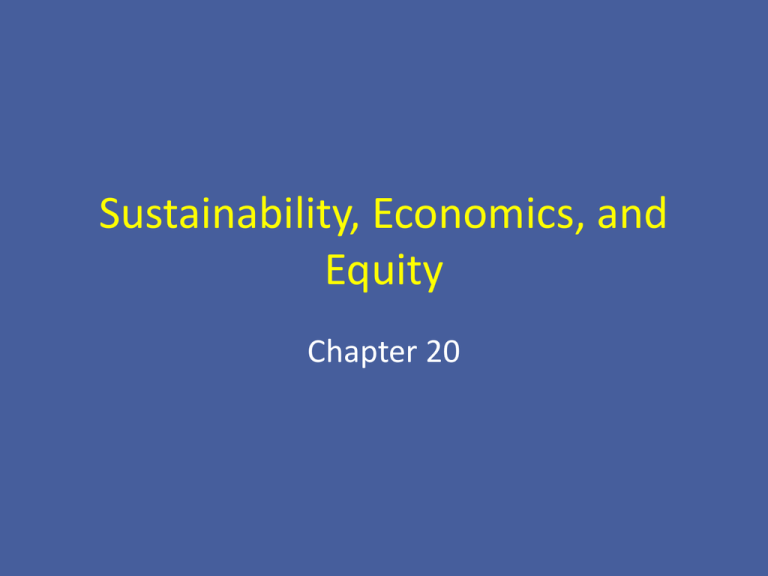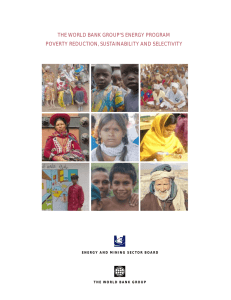Sustainability, Economics, and Equity Chapter 20
advertisement

Sustainability, Economics, and Equity Chapter 20 Sustainability • Sustainability a. when the needs of the present generation are met without compromising the ability of the future generations to meet their own needs b. economics - examines how humans allocate scarce resources in the production, distribution, and consumption of goods and services • Supply, Demand, and the Market a. Market Economies (engage in trade) - doesn’t account for externalities - law of demand - law of supply b. What if we included externalities? 1. reduction in what is produced 2. include taxes, costs for pollution 3. raises the price of good/service, and lowers demand • Wealth and Productivity a. measured in terms of productivity and consumption b. GDP - gross domestic product - value of all products and services produced in a year in a given country - 4 types of spending 1. consumer spending 2. investments 3. government spending 4. exports minus imports c. GPI 1. genuine progress indicator 2. measures of personal consumption, income distribution, levels of higher education, resource depletion, pollution, and health of a population Capital and Human Welfare • Capital – totality of our economic assets a. natural (air, wind) b. human (knowledge and abilities) c. manufactured (all goods and services produced) • Market Failure a. when the economic system does not appropriately account for all costs (externalities) • Environmental economics a. examines cost and benefits of policies and procedures that seek to regulate or limit air and water pollution or other causes of environmental degradation b. Valuation - putting value to intangible benefits ex) scenic views, spotted owl - 2004 Millennium Ecosystem * categorized the variety of services that ecosystems provide for the benefit of humans Laws and Regulations to Protect our Natural and Human Capital • Environmental Worldview a. anthropocentric – human-centered 1. nature has an instrumental value to provide for our needs b. ecocentric – earth-centered 1. places equal value on ecosystem and humans c. biocentric – life-centered 1. humans are just one of the many species d. Precautionary principle 1. 1987 Montreal Protocol - applied to global change (CFCs) • World Agencies a. United Nations (UN) 1. maintaining world peace 2. 4 important organizations * UNEP * World Bank * WHO * UNDP Organizations Roles United Nations Environment Programme • Kenya (UNEP) • Gathering environmental info, conducting research, assessing environmental problems • Negotiating treaties - Convention on Biological Diversity - CITES - Montreal Protocol World Bank World Health Organization (WHO) • Washington, DN • Financial assistance to developing countries to reduce poverty and promote growth * Improve human health by monitoring and assessing health trends and providing medical advice United Nations Development Programme • New York City (UNDP) • Address and facilitate issues of democratic governance, poverty reduction, crisis prevention/recovery, environment/energy issues, prevention of spread of disease • United States Agencies Organizations Roles Earth Day, April 22, 1970 Birthday representing connectedness of environment and human society Environmental Protection Agency (EPA) • Washington, DC • President Nixon • Oversees all government efforts related to the environment Occupational Safety and Health Administration (OSHA) • President Nixon • Enforces health and safety regulations • Prevents injuries, illnesses and deaths in workplace Department of Energy • President Jimmy Carter • Advance the energy and economic security of the U.S. Measuring and Achieving Sustainability • The Human Development Index (HDI) a. 3 basic measures 1. life expectancy 2. knowledge and education 3. standard of living b. used by UNDP c. ranks countries in order of development - determines developed and developing • Human Poverty Index (HPI) a. investigates the proportion of a population suffering from deprivation in a country with a high HDI b. 3 measures 1. longevity (living past 40) 2. knowledge (illiteracy rate) 3. standard of living • Environmental Policy Cycle • Deterrents and Incentives a. command-and-control approach 1. sets regulations for emissions and controls them with fines or other punishments b. incentive-based approach 1. financial or other incentives for lowering emissions based on profits and benefits * Combination of both is BEST approach with most changes c. green tax 1. placed on environmentally harmful activities d. triple bottom line 1. need to consider all three factors when making decisions in order to achieved sustainability Two Major Challenges of our Time • Reducing poverty and taking care of our environment • Poverty and Equity a. 1/6 of population lives in unsanitary conditions in informal settlements b. increases overuse of land, degradation of water, incidence of disease c. Millennium Development Goals (MDGs) 1. UN 2. committed to: - eradicate extreme poverty and hunger - achieve universal education - promote gender equality/empower women - reduce child mortality - improve maternal health - combat HIV/AIDS, malaria, etc - ensure environmental sustainability - develop global partnership for development 3. Green Belt Movement - replanting large tracts of land with trees * reduce erosion * improve soil quality * improve moisture retention * offer renewable source of fuel for cooking • Environmental Justice a. social movement b. equal enforcement of environmental laws c. equal enforcement on elimination of pollutants d. equality among all ethnic groups

